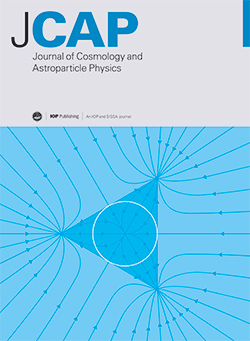Length-preserving biconnection gravity and its cosmological implications
IF 5.3
2区 物理与天体物理
Q1 ASTRONOMY & ASTROPHYSICS
Journal of Cosmology and Astroparticle Physics
Pub Date : 2024-12-12
DOI:10.1088/1475-7516/2024/12/034
引用次数: 0
Abstract
We consider a length preserving biconnection gravitational theory, inspired by information geometry, which extends general relativity, by using the mutual curvature as the fundamental object describing gravity. The two connections used to build up the theory are the Schrödinger connection, and its dual. In our geometric approach it can be seen that the dual of a non-metric Schrödinger connection possesses torsion, even if the Schrödinger connection itself does not, and consequently the pair (M,g,∇*) is a quasi-statistical manifold. The field equations are postulated to have the form of the standard Einstein equations, but with the Ricci tensor- and scalar replaced with the mutual curvature tensor, and the mutual curvature scalar, resulting in additional torsion-dependent terms. The covariant divergence of the matter energy-momentum does not vanish in this theory. We derive the equation of motion for massive particles, which shows the presence of an extra force, depending on the torsion vector. The Newtonian limit of the equations of motion is also considered. We explore the cosmological implications by deriving the generalized Friedmann equations for the Friedmann-Lemaitre-Robertson-Walker (FLRW geometry). They contain additional terms that can be interpreted as describing an effective, geometric type dark energy. We examine two cosmological models: one with conserved matter, and one where dark energy and pressure are related by a linear equation of state. The predictions of both models are compared with a set of observational values of the Hubble function, and with the standard ΛCDM model. Length-preserving biconnection gravity models fit well the observational data, and also align with ΛCDM at low redshifts (z < 3). The obtained results suggest that a modified biconnection geometry could explain the late-time acceleration through an effective geometric dark energy, as well as the formation of the supermassive black holes, as they predict a different age of our Universe as compared to standard cosmology.保长双连接引力及其宇宙学意义
利用互曲率作为描述引力的基本对象,我们考虑了一种受信息几何启发的保长双连通引力理论,它扩展了广义相对论。用于建立该理论的两个连接是Schrödinger连接及其对偶连接。在我们的几何方法中可以看到,即使Schrödinger连接本身不具有扭转,但非度量Schrödinger连接的对偶也具有扭转,因此对(M,g,∇*)是一个拟统计流形。假设场方程具有标准爱因斯坦方程的形式,但是用互曲率张量和互曲率标量代替了里奇张量和标量,从而产生了额外的与扭转相关的项。物质能量动量的协变散度在这个理论中并没有消失。我们推导了大质量粒子的运动方程,它显示了一个额外的力的存在,这取决于扭转矢量。还考虑了运动方程的牛顿极限。我们通过推导弗里德曼-勒梅特-罗伯逊-沃克(FLRW几何)的广义弗里德曼方程来探索宇宙学意义。它们包含额外的术语,可以解释为描述有效的几何型暗能量。我们研究了两种宇宙学模型:一种是守恒物质模型,另一种是暗能量和压力通过线性状态方程相关的模型。将这两个模型的预测结果与哈勃函数的一组观测值以及标准ΛCDM模型进行比较。保持长度的双连接引力模型很好地符合观测数据,并且在低红移(z < 3)处也与ΛCDM一致。所获得的结果表明,改进的双连接几何可以通过有效的几何暗能量来解释晚时间加速,以及超大质量黑洞的形成,因为它们预测了与标准宇宙学相比不同的宇宙年龄。
本文章由计算机程序翻译,如有差异,请以英文原文为准。
求助全文
约1分钟内获得全文
求助全文
来源期刊

Journal of Cosmology and Astroparticle Physics
地学天文-天文与天体物理
CiteScore
10.20
自引率
23.40%
发文量
632
审稿时长
1 months
期刊介绍:
Journal of Cosmology and Astroparticle Physics (JCAP) encompasses theoretical, observational and experimental areas as well as computation and simulation. The journal covers the latest developments in the theory of all fundamental interactions and their cosmological implications (e.g. M-theory and cosmology, brane cosmology). JCAP''s coverage also includes topics such as formation, dynamics and clustering of galaxies, pre-galactic star formation, x-ray astronomy, radio astronomy, gravitational lensing, active galactic nuclei, intergalactic and interstellar matter.
 求助内容:
求助内容: 应助结果提醒方式:
应助结果提醒方式:


